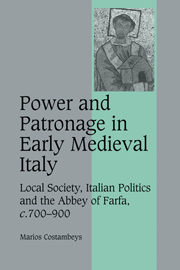 Power and Patronage in Early Medieval Italy
Power and Patronage in Early Medieval Italy Book contents
- Frontmatter
- Contents
- List of illustrations
- Acknowledgements
- Note on charter editions
- List of abbreviations
- Maps
- 1 INTRODUCTION
- 2 PATRONAGE AND LOMBARD RULERS
- 3 AUTHORITY, RULERSHIP AND THE ABBEY
- 4 THE MONKS AND ABBOTS OF FARFA: IDENTITIES AND AFFILIATIONS
- 5 SABINE LANDS AND LANDOWNERS
- 6 ELITE FAMILIES IN THE SABINA
- 7 FARFA AND ITALIAN POLITICS IN THE LOMBARD ERA
- 8 FARFA, ITALIAN POLITICS AND THE CAROLINGIANS
- Bibliography
- Index
- Cambridge Studies in Medieval Life and ThoughtFourth Series
7 - FARFA AND ITALIAN POLITICS IN THE LOMBARD ERA
Published online by Cambridge University Press: 17 July 2009
- Frontmatter
- Contents
- List of illustrations
- Acknowledgements
- Note on charter editions
- List of abbreviations
- Maps
- 1 INTRODUCTION
- 2 PATRONAGE AND LOMBARD RULERS
- 3 AUTHORITY, RULERSHIP AND THE ABBEY
- 4 THE MONKS AND ABBOTS OF FARFA: IDENTITIES AND AFFILIATIONS
- 5 SABINE LANDS AND LANDOWNERS
- 6 ELITE FAMILIES IN THE SABINA
- 7 FARFA AND ITALIAN POLITICS IN THE LOMBARD ERA
- 8 FARFA, ITALIAN POLITICS AND THE CAROLINGIANS
- Bibliography
- Index
- Cambridge Studies in Medieval Life and ThoughtFourth Series
Summary
INTRODUCTION
This book opened with a quotation from a diploma of Lothar issued in December 840, some six months after the death of his father and a year after his eldest son, Louis (II), had been earmarked to be king of Italy. Through this document, Lothar confirmed what he had already legislated upon in 824: that Farfa should be reinvested with properties that the popes had taken from it, and that all its properties should be immune from papal jurisdiction. Most significantly, the properties in question were said to be ‘located both in the Sabine territory and in Romania’: that is, Lothar drew an explicit distinction between the Sabina and the territory formally attached to the city of Rome. To draw such a boundary was to recognize the identity of the latter, certainly; but it was also to deny the claims to some kind of jurisdiction in the Sabina, ambiguous and mutable though those had been, made in some papal writings of the later eighth and early ninth centuries. Quite consciously, also, Lothar was drawing limits around the jurisdictional powers of the popes within the territory of Rome: at the very least, they did not extend to Farfa's properties. Nor was the enunciation of these provisions in 840 any belated recognition of those concerns, or of their implications.
- Type
- Chapter
- Information
- Power and Patronage in Early Medieval ItalyLocal Society, Italian Politics and the Abbey of Farfa, c.700–900, pp. 250 - 272Publisher: Cambridge University PressPrint publication year: 2007


